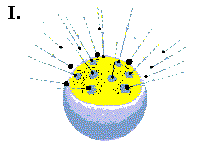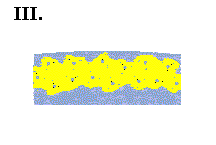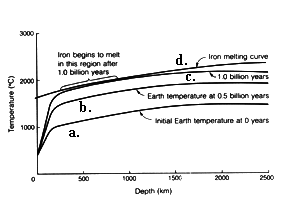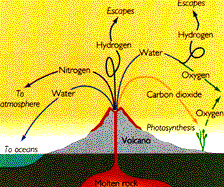Origin and Differentiation of the Earth
Current hypotheses have the Earth (and the other planets) formed from material
in the solar disk as described in the previous
lecture. The sequence of events leading to a differentiated Earth
are presented below.
 |
The Earth formed by the process known as Accretion.
This process is "gravity-driven", and involves gravitational attraction
of material in the vicinity of the solar disk to the growing Earth.
The process continues to this date with meteorite impacts, but must have
occurred at a very high rate while the planet was initially forming.
Release of energy during impact of the accreting bodies produced heat.
Owing to the fact that the rocky material which comprises the Earth is
a good heat insulator, heat from the accretion process was maintained below
the Earth's surface, as each hot layer was subsequently covered by, and
insulated by overlying accretion debris.
|
 |
As the Earth grew larger, it's gravitational field increased
and it began to compact as a result of the growing mass of largely unconsolidated
material. The process of compaction also produced heat, which
further served to increase the temperature within the still-forming planet.
At this stage of planetary formation, the Earth was "warm" with internal
temperatures probably reaching as high as 1500 degrees Centigrade. |
 |
In addition to heat generated by the processes of accretion
and compaction, the newly formed Earth also contained relatively small
quantities of radioactive elements (esp. isotopes of U, K and Rb). [Some
of these isotopes, such as U(238) have a half life of about 4.5Ga, and
consequently about twice as many radioactive atoms existed at this time
relatively to the present.] As these radioactive atoms spontaneously
disintegrate by nuclear fission, energy is released in the form of heat. |
Immediately following accretion, the Earth must have been uniform
or homogeneous in composition. Furthermore, it would have lacked both an
atmosphere and hydrosphere.
The three main processes involved in planetary formation (I, II and
III above) each contributed heat to the newly formed planet. The
figure below (Fig. 1-9 in your textbook) represents results of calculations
of interior temperatures following planetary formation. The lowermost
curve (a) gives the temperature vs depth profile immediately after
accretion and compaction (i.e., without radioactive heat production).
Radioactive decay resulting in a warming of the interior as indicated by
curves b and c. At some point in time, radioactive
heating resulted in temperatures exceeding the melting point for iron (curve
d).
 Once temperatures were high enough for iron (and other lower-melting-point
minerals) to begin to melt, a profound event occurred. This event
is known as the Iron Catastrophy. Once the interior
began to partially melt, high density, iron-rich liquids began to sink
toward the center of the earth, while low-density liquids rose toward the
surface. In other words, the planet began to differentiate (seperate)
into a density stratified body. As dense material sank toward the
center, more energy was released in the form of heat, causing the temperatures
to increase even more, resulting in more melting, more sinking of iron,
and more heat being released ( a positive-feedback process). It is
likely that much of the Earth melted in this process. There is strong
evidence to suggest that the outer portions of the Moon became completely
molten, thus forming a magma ocean. The same may have also
happened on the Earth. The sequence of events and final result are
illustrated in the figure below (Fig. 1-9 in your textbook):
Once temperatures were high enough for iron (and other lower-melting-point
minerals) to begin to melt, a profound event occurred. This event
is known as the Iron Catastrophy. Once the interior
began to partially melt, high density, iron-rich liquids began to sink
toward the center of the earth, while low-density liquids rose toward the
surface. In other words, the planet began to differentiate (seperate)
into a density stratified body. As dense material sank toward the
center, more energy was released in the form of heat, causing the temperatures
to increase even more, resulting in more melting, more sinking of iron,
and more heat being released ( a positive-feedback process). It is
likely that much of the Earth melted in this process. There is strong
evidence to suggest that the outer portions of the Moon became completely
molten, thus forming a magma ocean. The same may have also
happened on the Earth. The sequence of events and final result are
illustrated in the figure below (Fig. 1-9 in your textbook):

The differentiation resulted in formation of an iron-rich core
(ca. 90% Fe, 10% Ni), a low density crust rich in silicon, aluminum
and oxygen, and an intermediate density mantle rich in magnesium,
silicon and oxygen. The efficiency of the differentiation can be judged
by the following table showing the relative abundance of elements in the
whole Earth compared to that in the crust:
| Element |
Wt.% in Whole Earth |
Wt. % in Crust |
| Oxygen |
30 |
46
|
| Iron |
35
|
6
|
| Silicon |
15
|
28
|
| Magnesium |
13
|
4
|
| Nickel |
2.4
|
<1
|
| Calcium |
1.1
|
2.4
|
| Aluminum |
1.1
|
8
|
| Sodium + Potassium |
<1
|
4.4
|
 |
Another profound result of the Iron Catastrophy
was the initial formation of the primitive atmosphere and hydrosphere.
As the Earth began to melt, gases would be released in a fashion similar
to that observed in contemporary volcanoes. Release of enormous quantities
of volatiles during wholesale melting, resulted in the generation of the
primitive atmosphere and hydrosphere. I use the term primitive, because
these volcanic gases would have been very toxic, would have contained little
or no free oxygen, and certainly would have been incapable of supporting
any life. It would take an additional billion years or so, before
primitive organisms could develop and begin the process of photosynthesis
necessary to generate an atmosphere at all like the one we enjoy and rely
upon today.
|
Another consequence of the Iron Catastrophy is that it
resulted in a very hot planetary interior. The large temperature
gradient between the interior and the surface results in heat transfer
from the interior to the surface. The dominant mode of Earth's heat
transfer is convection, primarily in the still-hot, plastic portion
of the mantle known as the asthenosphere. This convection is responsible
for the many dynamic characteristics of the Earth today. Indeed,
it can be said that the past 4.6 Ga of Earth's history can be described
as the dynamic consequences of the Earth's internal mechanism of transferring
heat from the interior. These consequences include, but are not limited
to the following:
-
Plate Tectonics
-
Volcanism
-
Mountain Building
-
Recycling of Earth Materials
 |
The diagram to the left presents a very simplified model
showing how convection in the mantle might be the driving force of
plate tectonics. Hot matter from deep within the interior rises
beneath divergent plate boundaries (rifts) and flows apart carring
with it the overlying, rigid lithospheric plate. Plates sink with
cold matter along convergent plate boundaries (subduction zones).
|
Terms and Concepts which you should understand:
-
Core
-
inner solid core
-
outer liquid core
-
Mantle
-
Crust
-
Asthenosphere
-
Lithosphere
-
MOHO
 This page created with Netscape Navigator Gold
This page created with Netscape Navigator Gold




